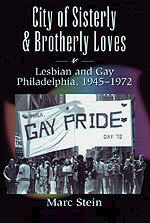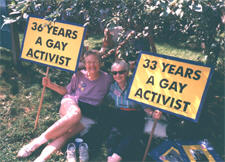 |

 |
|
Lesbian & Gay Philadelphia City of Sisterly & Brotherly Love: Lesbian & Gay Philadelphia 1945-1972 by Marc Stein; University of Chicago Press; 457 pages; $35.  From its beginnings, lesbian and gay American history has focused on the major
cities of the United States: Boston, New York, Washington, Chicago, Los
Angeles, San Francisco. Though it is one of our largest cities, Philadelphia
has been mostly ignored.
From its beginnings, lesbian and gay American history has focused on the major
cities of the United States: Boston, New York, Washington, Chicago, Los
Angeles, San Francisco. Though it is one of our largest cities, Philadelphia
has been mostly ignored.
"When I began my research, Philadelphia was probably North American's biggest city without a reputation for a sizable lesbian and gay community," writes historian Marc Stein, who himself admitted that he "did not like Philadelphia very much." Proximity to New York City and Washington, D.C. didn't help matters any, as many young Philadelphians left their home town for the more exciting metropolis nearby. "It's like night and day," notes George Axler, who moved from Philly to Gotham in 1950. "New York i! s so much more diverse and so much more stimulating. . . . The most interesting people come to New York to make their lives here." The belief that Philadelphia is a backwater, at least for lesbian and gay men, is unfair. As Stein points out, "Philadelphians organized some of the country's first lesbian and gay political demonstrations, produced some of the country's most widely circulating lesbian and gay publications, and were in the forefront of innovative political tendencies, including heterosocial lesbian and gay activism, homophile lesbian militancy, gay sexual radicalism, multiracial gay liberationism, and African American lesbian feminism."
City of Sisterly & Brotherly Loves: Lesbian and Gay Philadelphia, 1945-1972 refutes the notion that Philadelphia doesn't have a queer community worth writing about. It also establishes Marc Stein as an important historian with a mind of his own and a subject that hasn't been touched before. Stein's Philadelphia story begins with the end of World War II, when so many lesbians and gay men discovered themselves. It ends in 1972, when the City of Brotherly (and Sisterly) Love staged its very first "gay pride" parade. If there is a connecting thread in City of Sisterly & Brotherly Loves it is that lesbian and gay Philadelphians often crossed the borders of sex to form heterosocial relationships and communities: "lesbians and gay men paradoxically have used same-sex sexualities to set up, invent, multiply, and modify cross-sex relationships." "Creating predominantly divergent households and predominantly convergent neighborhoods, lesbians and gay men mapped the geography of their everyday relationships." Still, queer Philadelphians never denied or challenged the fundamental difference between lesbians and gay men: lesbians are women and gay men are men. "Reviewing the many accomplishments of Philadelphia's lesbian and gay communities between 1945 and 1972, I am struck most by the ways in which these communities both challenged dominant cultural ideas about sexuality and reinforced dominant cultural ideas about sex.! Criticizing the notion that straights were superior to lesbians and gay men, they embraced the notion that women and men were fundamentally different," Stein concludes.
As the history of Philadelphia's Janus Society indicates, cooperation between lesbians and gay men can only go so far. Born out of the ashes of Mattachine Philadelphia in 1961, the Janus Society of Delaware Valley was a mixed-gender organization presided by a lesbian, Mae Polakoff. Under her leadership the Janus Society became a leader of the American homophile movement and hosted the first conference of the East Coast Homophile Organizations (ECHO) in 1963. The Janus Society's heterosocial heyday ended in shortly after the ECHO conference, when Clark Polak and Marge McCann opposed one another for the position of president of Janus. McCann, like other Janus women, favored "direct action tactics and minority-group respectability." For their part, Polak and his supporters "adopted a politics of sexual liberationism." Polak was elected, and immediately showed his concern for lesbians by starting a newsletter, Drum, that featured nude male photos and the malerotic comic strip "Harry Chess". Though Drum naturally outsold other homophile publications, it did not impress the women who walked out of Janus in droves. Under Polak's too-long leadership (1963-69) the Janus Society became "gay, militant, and misogynist", and could not survive Polak's federal indictment for mailing "obscene" material (like Drum). Very few people mourned the fall of Clark Polak and his Janus Society. By then the Stonewall militants had thrown the rocks that were felt around the world; and most of Philly's lesbian and gay activists had moved on to other groups. Though the post-Stonewall Gay Liberation Front and Radicalesbians were mostly male and exclusively female respectively, they maintained the mutual respect and joint efforts between the genders that marked Philadelphia activism during the homophile era. By the time the "City of Sisterly and Brotherly Loves” held its first pride march, Philadelphia had placed itself at the unacknowledged forefront of the lesbian and gay movement. |
 © 1997-2000 BEI
© 1997-2000 BEI
 Barbara Gittings and Kay Tobin Lahusen appearing in the PBS documentary After Stonewall
Barbara Gittings and Kay Tobin Lahusen appearing in the PBS documentary After Stonewall